The name “Niaouli” is derived from Nyelayu, a New Caledonian language, translated into Niaouli in French. The botanical name is Melaleuca viridiflora or Melaleuca quinquenervia, commonly known as Niaouli or “broad-leaved paperbark”. The genus name “Melaleuca” means “black and white” – referring to the colour of the bark which resembles the bark of the birch tree. And “quinquenervia” meaning “five lines” refers to the lanceolate shaped leaves with their five nerve fibres. “Viridiflora” means “green flowered”. The flowers are typical for Melaleuca: roundish-spike shaped. The tree, being similar to Eucalyptus in appearance and aroma, has a pliable trunk and a kind of “peel-off” outer appearance (cf. “paperbark”) which is also typical to the other Melaleucas such as Cajeput and the different tea tree species. Its fruits become hard like wood nearly after maturation.

The evergreen Niaouli tree belongs to the Myrtaceae plant family and is native to the tropical regions of New Caledonia, the French Pacific Islands and also to coastal areas of Eastern Australia. Niaouli trees like oceanic climates… Characteristic of the tree is its robustness and adaptability. Once rooted, it can hardly be eradicated. In its home country New Caledonia vast Niaouli-forests can be found, and the inhabitants believe in the healing powers of the plant. They are also convinced that the leaves falling to the ground provide a healthy environment due to being strongly disinfectant – a protective factor being very important in those hot and humid climates. The tree can also be used to purify water. Furthermore, the Niaouli tree is said to dispel insects by spreading aromatic substances and thereby possibly preventing Malaria. When the leaves are crushed, they release an intense aroma. It can be described as refreshing, camphoraceous, spicy, herbaceous and slightly sweet.

Niaouli essential
The essential oil of Niaouli is obtained through steam distillation of the leaves and twigs. 70 kg of them yield about 1 kg of the essential oil. Niaouli is also growing wild in Madagascar. It may be that – similar to the Ravintsara tree – the Malayo-Pacific sailors of the 10/11th century crossing the Indian Ocean and settling in Madagascar, have brought this tree with them. Some people claim that the essential oil from there is of higher quality than the one from the other parts of the world.
The main chemical components are: Oxydes (1,8 Cineol), Monoterpenes, Sesquiterpenole, Monoterpenole and Sesquiterpene.
In the middle of the 19th century the essential oil was imported to Europe by French traders. Already in the end of the 18th century doctors in French hospitals used it as an obstetric ward due to its antiseptic effects – the reason why the cosmetic industry still uses it today as an ingredient in toothpaste and mouth sprays. It prevents inflammation in the mouth. Apart from that, it is very good for the mucous membrane and is able to strengthen the gums. It is also very appropriate for clearing oily and infected skin. Its tissue firming qualities make it suitable for cellulite blends. With its wonderful fragrance Niaouli is always welcome for a refreshing, revitalizing bath or for sauna visits.
Thanks to its antiseptic, anti-viral, anti-bacterial, anti-inflammatory and expectorant qualities, Niaouli is an excellent remedy to fight infectious such as colds, whooping cough, asthma, sinusitis, sore throats, catarrh and laryngitis – one can say: all the complaints relating to the respiratory tract. Furthermore, it is effective if enteritis, dysentery, intestinal parasites, cystitis and urinary infections are the problem. The stamina of the immune system profits from these properties. Also, pains caused by rheumatism and neuralgia find relief.
Also, if wounds need to get washed or ulcers, acne, blemishes, boils, burns, cuts, insect bites require treatment, Niaouli essential oil is very helpful. The pain relieving property of the oil has made it very popular over time. Niaouli oil is well advised in case of muscular and joint pain as well as in case of migraines and headaches. A combination with Helichrysum and Spike Lavender oil is a good recipe for earaches and tinitus.

Preparing Niaouli distillation on the East coast of Madagascar
The robustness and at the same time its flexibility of the tree may be a signature for its capability of stabilizing the immune system – indicating the psychic and spiritual values of Niaouli. Also the lightness and “peel -off” character of the bark may be seen as a tendency of the special tree to open up, to give and not to restrain its strength or protect itself unnecessarily. Its protection actually lies in its powerful essential oil. The oil promotes adrenal and pituitary activity. And it gives strength and “rootedness” by clearing the “midway” areas of our physical system: the lungs – and with them the heart – so that a healthy energy flow between the “above and below” is re-established. No suprize that Niaouli oil is very useful if we want to give support to our emotional energies and thereby make it easier to handle stress and strain in a more serene way.
Inhaling such an essential oil fills body, mind and soul with more vitality and zest for life. Niaouli is nearly like “drinking” fresh air. It straightens up our spinal energy and its subtle “vortical” flow. Thereby it helps us to confront the usual conflicts within our daily tasks. These balancing psychic effects are supported by the Dopamine producing properties which the essential oil is able to provide.
Some recipes
Varicose veins (Franchomme)
• Niaouli: 2ml
• Mastik: 1ml
• Helichrysum: 1ml
• Cypress: 3ml
• Tamanu: 5ml
vegetal Gel: 100 g
2-3 applications per day in situ, for 20 days
Herpes labialis (Nard)
• Niaouli: 3ml
• Tea tree: 1ml
• Peppermint: 0.5ml
• Saro: 2ml
• Tamanu: 10ml
2-3 drops locally – 6-8 times a day until healed

Cellulitis (Franchomme)
• Niaouli: 1ml
• Eucalyptus citriodora: 1.5ml
• Lemon: 2ml
• Cedar atlas: 2ml
• Cypress: 2ml
• Hazelnut vegetal oil: 100ml
2-3 applications per day in situ, for 30 days
Cutaneous activation with circulatory and sclerosing aim
Laryngitis (Baudoux)
• Niaouli: 1ml
• Thyme thuyanol: 1.5ml
• Rosewood: 1ml
3 drops of the mixture on 1/4 sugar cube or in a teaspoon of olive oil
4 times a day between meals for 5 days
Acute otitis in children (Baudoux)
• Niaouli: 0,2ml
• Helichrysum: o,1ml
• Eucalyptus radiata: 0,2ml
• Annual Tansy: 0,05ml
• Hazelnut vegetal oil: 15ml
2 drops of the mixture in the ear canal or on a cotton wick 3-4 times a day for 3 days
Experiences with Niaouli oil
Acne
“I have had acne since I was a young girl. I’ve tried everything to get my acne to go away. I had been on antibiotics, used witch hazel, lotions, creams, everything to get my skin to clear up. Nothing seemed to work until I tried a blend with Melaleuca oils…
I wash with a facial cream that I’ve found that works for me and add a drop or two to the quarter size dollop I wash with, and then, after I’m done, I mix 3-4 drops of the blend, including Niaouli oil, with an oil free moisturizer and it’s like magic. My skin has cleared up, and I feel better than ever. If I ever do get a pimple, I simply put a drop or two directly on the spot, and within a day or two it’s gone. Plus, it smells delicious.”
http://www.plantextractsinc.com
Flu
“Obviously, a virus like that, which inevitably triggers coughs, pains and ENT infectious outbreaks, requires a powerful and effective treatment. The essential oil capsules based on
• Eucalyptus globulus
• Niaouli,
• Rosemary cineole
are the nerve of the war. I personally add a few drops of EO of
• Cinnamon or
• Oregano
during the day, in a teaspoon of Olive oil, just to make a big impact – these last mentioned two essential oils are very strong natural “antibiotics”.
http://www.danielefesty.com/2014/12/comment-jai-soigné-ma-grippe-avec-les-huiles-essentielles.html
Shingles
“As my clients were all in so much pain and could not bear to touch the area or have anything against their skin in the affected area, there was no choice to consider anything other than a spray application. In each case, I selected the same three essential oils:
• Niaouli (Melaleuca quinquenervia ct 1,8 cineole)
• Ravensara (Ravensara aromatica) and
• Melissa (Melissa officinalis)
each receiving a dilution of no less than 5% with a determined amount of Tamanu oil in an aromatic organic Lavender hydrosol to heighten the efficacy of the blend from the start.
https://jamilaharomatherapy.wordpress.com/
To conclude
All in all, Niaouli oil can be called a power oil of multiple healing and a strong helper for awakening our self-confidence and trust in our inner strength. My own experience in terms of helping myself or others with respiratory problems and re-establishing energy for the system by suggesting the use of Niaouli oil has always been very convincing.
On the way back from my “Niaouli East coast Madagascar tour” a long time ago, there was a little girl… she was held in her mother’s arms on the roadside, covered with a horribly infected skin rash all over her legs… I gave them a bottle of Niaouli oil in Coconut oil and advised the mother how to use it… My accompanying “guard” wrote me a letter a few weeks later that the girl was totally healed and the mother full of joy and gratitude…
Yes, Mother Nature, thank you forever! Let the mothers awaken to aromatherapy! Well, it is happening already, and definitely a very feminine approach to self-healing considering the percentage of women and men in all kinds of aromatherapy teaching events around the globe… 🙂


